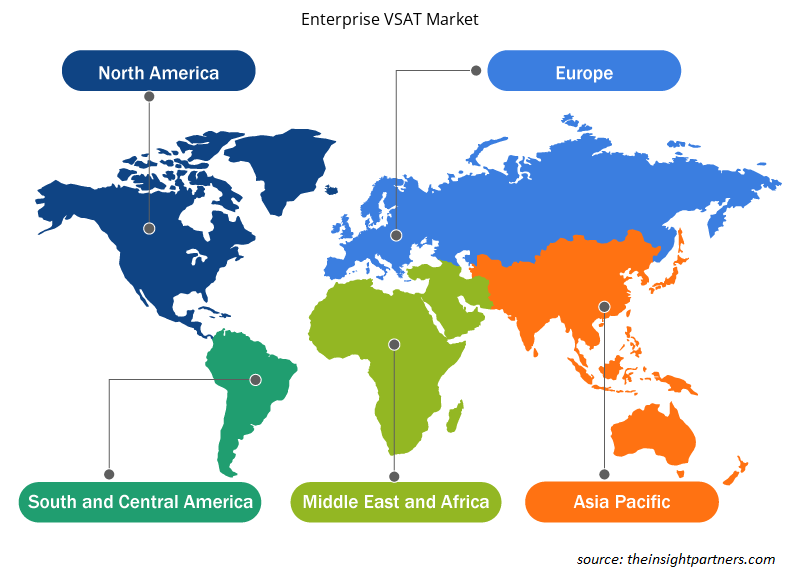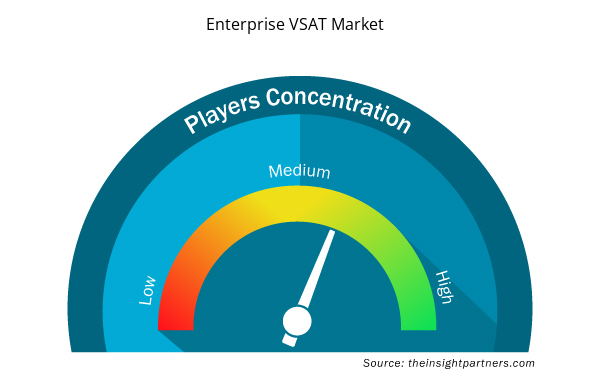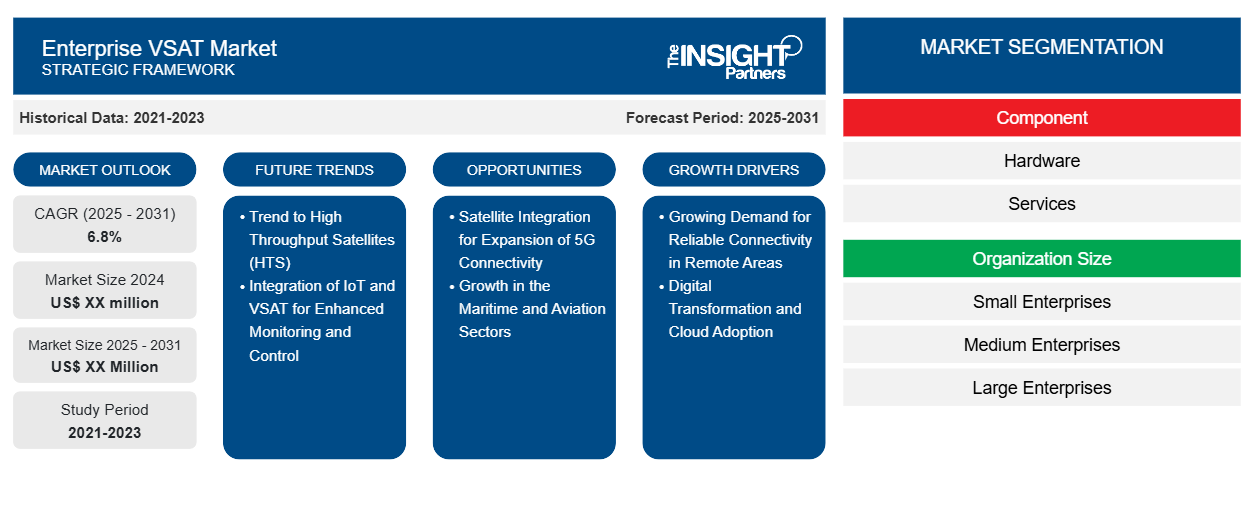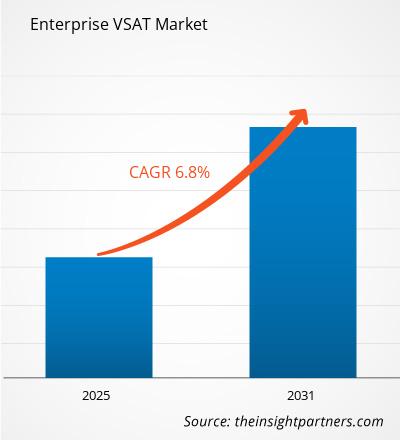Si prevede che il mercato Enterprise VSAT registrerà un CAGR del 6,8% dal 2023 al 2031, con una dimensione di mercato in espansione da XX milioni di dollari USA nel 2023 a XX milioni di dollari USA entro il 2031.
Il report è segmentato per Componente (Hardware, Servizi); Dimensioni dell'organizzazione (Piccole imprese, Medie imprese, Grandi imprese); Applicazione (Sanità, IT e Telecomunicazioni, Governo, Istituzioni educative, BFSI, Vendita al dettaglio, Energia e servizi di pubblica utilità, Altro). L'analisi globale è ulteriormente suddivisa a livello regionale e nei principali paesi. Il report offre il valore in USD per l'analisi e i segmenti di cui sopra.
Scopo del rapporto
Il report Enterprise VSAT Market di The Insight Partners mira a descrivere il panorama attuale e la crescita futura, i principali fattori trainanti, le sfide e le opportunità. Ciò fornirà spunti a vari stakeholder aziendali, come:
- Fornitori/produttori di tecnologia: per comprendere le dinamiche di mercato in evoluzione e conoscere le potenziali opportunità di crescita, consentendo loro di prendere decisioni strategiche informate.
- Investitori: condurre un'analisi completa delle tendenze in merito al tasso di crescita del mercato, alle proiezioni finanziarie del mercato e alle opportunità esistenti lungo la catena del valore.
- Enti di regolamentazione: regolamentano le politiche e le attività di controllo sul mercato allo scopo di ridurre al minimo gli abusi, preservare la fiducia degli investitori e sostenere l'integrità e la stabilità del mercato.
Segmentazione del mercato VSAT aziendale
Componente
- Hardware
- Servizi
Dimensione dell'organizzazione
- Piccole Imprese
- Medie Imprese
- Grandi Imprese
Applicazione
- Assistenza sanitaria
- IT e telecomunicazioni
- Governo
- Istituzioni educative
- BFSI
- Vedere al dettaglio
- Energia e servizi
- Altro
Geografia
- America del Nord
- Europa
- Asia-Pacifico
- America del Sud e Centro
- Medio Oriente e Africa
Geografia
- America del Nord
- Europa
- Asia-Pacifico
- America del Sud e Centro
- Medio Oriente e Africa
Personalizza questo report in base alle tue esigenze
Riceverai la personalizzazione gratuita di qualsiasi report, comprese parti di questo report, o analisi a livello nazionale, pacchetto dati Excel, oltre a usufruire di grandi offerte e sconti per start-up e università
- Scopri le principali tendenze di mercato in questo rapporto.Questo campione GRATUITO includerà analisi di dati che spaziano dalle tendenze di mercato alle stime e alle previsioni.
Fattori di crescita del mercato VSAT aziendale
- Domanda crescente di connettività affidabile in aree remote: l'espansione in aree remote o sottoservite richiede la necessità di soluzioni di comunicazione affidabili e ad alta velocità. Con la convenienza economica dell'offerta di servizi Internet e dati a banda larga tramite la tecnologia VSAT (Very Small Aperture Terminal) dove le reti terrestri convenzionali non sono accessibili o pratiche, ciò è particolarmente vitale per settori quali petrolio e gas, estrazione mineraria, agricoltura e operazioni marittime situate in aree remote.
- Trasformazione digitale e adozione del cloud: le aziende stanno adottando sempre più soluzioni basate sul cloud e strumenti digitali per semplificare le operazioni, migliorare la collaborazione e aumentare la produttività. Questa trasformazione digitale richiede una connessione Internet stabile e ad alte prestazioni, che VSAT può fornire anche in aree con infrastrutture terrestri limitate. Man mano che le aziende spostano più carichi di lavoro sul cloud, i sistemi VSAT stanno diventando un abilitatore essenziale per l'accesso ininterrotto ad applicazioni basate sul cloud, archiviazione dati e comunicazione in tempo reale.
Tendenze future del mercato VSAT aziendale
- Tendenza verso i satelliti ad alta capacità (HTS): l'industria si è spostata verso l'uso di HTS, che forniscono diverse migliaia di volte più larghezza di banda e una velocità di dati molto maggiore rispetto ai satelliti tradizionali. La tecnologia HTS consente una maggiore scalabilità ed economie per le aziende che necessitano di applicazioni più intensive in termini di dati come videoconferenze, trasferimenti di file di grandi dimensioni e streaming di dati. Questa è una tendenza che sta adottando sempre più sistemi VSAT in settori ad alta intensità di larghezza di banda come media, sanità e istruzione.
- Integrazione di IoT e VSAT per monitoraggio e controllo migliorati: i dispositivi IoT vengono sempre più integrati con le reti VSAT nei settori agricolo, dei trasporti e della logistica. I sensori IoT possono inviare dati in tempo reale da remoto alle reti VSAT per il monitoraggio remoto, la manutenzione predittiva e l'automazione del processo decisionale. Questa tendenza è altamente rilevante nei settori in cui le risorse o le operazioni sono disperse e pertanto il monitoraggio e la gestione centralizzati sono essenziali per ottimizzare l'efficienza e ridurre i rischi operativi.
Opportunità di mercato VSAT aziendali
- Integrazione satellitare per l'espansione della connettività 5G: con l'implementazione mondiale delle reti 5G, si verifica un corrispondente aumento delle opportunità di integrare la comunicazione satellitare, inclusa VSAT, con l'infrastruttura 5G. Ciò migliorerà la copertura per gli utenti aziendali in luoghi remoti o difficili da raggiungere che il 5G tradizionale non potrebbe fornire. Unendo i vantaggi della bassa latenza e del trasferimento dati ad alta velocità tramite 5G con la copertura onnipresente tramite VSAT, le aziende possono fornire una connettività senza interruzioni in settori critici per la missione come logistica, assistenza sanitaria e sicurezza pubblica. Ciò può anche aiutare a colmare il divario nei mercati emergenti e sbloccare nuovi flussi di entrate per il fornitore di VSAT.
- Crescita nei settori marittimo e aeronautico: i settori marittimo e aeronautico rappresentano notevoli opportunità per il mercato Enterprise VSAT. Questi settori richiedono sistemi di comunicazione satellitare affidabili e ad alta velocità per consentire una connettività senza interruzioni per i membri dell'equipaggio, il monitoraggio operativo, la navigazione e i servizi ai passeggeri. La crescente necessità di connettività Internet ad alta velocità su navi, aerei e imbarcazioni remote sta guidando la domanda di soluzioni VSAT avanzate. Con l'espansione globale dei settori marittimo e aeronautico, l'adozione di soluzioni VSAT di livello aziendale continuerà ad aumentare.
Approfondimenti regionali sul mercato Enterprise VSAT
Le tendenze regionali e i fattori che influenzano il mercato Enterprise VSAT durante il periodo di previsione sono stati ampiamente spiegati dagli analisti di Insight Partners. Questa sezione discute anche i segmenti e la geografia del mercato Enterprise VSAT in Nord America, Europa, Asia Pacifico, Medio Oriente e Africa e America centrale e meridionale.

- Ottieni i dati specifici regionali per il mercato Enterprise VSAT
Ambito del rapporto di mercato Enterprise VSAT
| Attributo del report | Dettagli |
|---|---|
| Dimensioni del mercato nel 2023 | XX milioni di dollari USA |
| Dimensioni del mercato entro il 2031 | XX milioni di dollari USA |
| CAGR globale (2023-2031) | 6,8% |
| Dati storici | 2021-2022 |
| Periodo di previsione | 2024-2031 |
| Segmenti coperti | Per componente
|
| Regioni e Paesi coperti | America del Nord
|
| Leader di mercato e profili aziendali chiave |
|
Densità degli attori del mercato Enterprise VSAT: comprendere il suo impatto sulle dinamiche aziendali
Il mercato Enterprise VSAT Market sta crescendo rapidamente, spinto dalla crescente domanda degli utenti finali dovuta a fattori quali l'evoluzione delle preferenze dei consumatori, i progressi tecnologici e una maggiore consapevolezza dei vantaggi del prodotto. Con l'aumento della domanda, le aziende stanno ampliando le loro offerte, innovando per soddisfare le esigenze dei consumatori e capitalizzando sulle tendenze emergenti, il che alimenta ulteriormente la crescita del mercato.
La densità degli operatori di mercato si riferisce alla distribuzione di aziende o società che operano in un particolare mercato o settore. Indica quanti concorrenti (operatori di mercato) sono presenti in un dato spazio di mercato in relazione alle sue dimensioni o al valore di mercato totale.
Le principali aziende che operano nel mercato Enterprise VSAT sono:
- Società di telecomunicazioni Comtech.
- Cambium Networks, Ltd.
- Telefónica SA
- Embratel
- Sistemi di rete Hughes, LLC
- Nelco
Disclaimer : le aziende elencate sopra non sono classificate secondo un ordine particolare.

- Ottieni una panoramica dei principali attori del mercato Enterprise VSAT
Punti chiave di vendita
- Copertura completa: il rapporto esamina in modo completo i prodotti, i servizi, le tipologie e gli utenti finali del mercato Enterprise VSAT, fornendo una panoramica olistica.
- Analisi degli esperti: il rapporto è compilato sulla base della conoscenza approfondita di esperti e analisti del settore.
- Informazioni aggiornate: il rapporto garantisce la pertinenza aziendale grazie alla copertura di informazioni recenti e tendenze nei dati.
- Opzioni di personalizzazione: questo report può essere personalizzato per soddisfare le esigenze specifiche del cliente e adattarsi in modo appropriato alle strategie aziendali.
Il rapporto di ricerca sul mercato Enterprise VSAT può quindi aiutare a guidare il percorso di decodifica e comprensione dello scenario del settore e delle prospettive di crescita. Sebbene possano esserci alcune preoccupazioni valide, i vantaggi complessivi di questo rapporto tendono a superare gli svantaggi.
- Analisi storica (2 anni), anno base, previsione (7 anni) con CAGR
- Analisi PEST e SWOT
- Valore/volume delle dimensioni del mercato - Globale, regionale, nazionale
- Industria e panorama competitivo
- Set di dati Excel


- Medical Enzyme Technology Market
- Aircraft Wire and Cable Market
- Semiconductor Metrology and Inspection Market
- Aerospace Forging Market
- Underwater Connector Market
- Smart Parking Market
- 3D Mapping and Modelling Market
- Hydrolyzed Collagen Market
- Constipation Treatment Market
- Electronic Signature Software Market

Report Coverage
Revenue forecast, Company Analysis, Industry landscape, Growth factors, and Trends

Segment Covered
This text is related
to segments covered.

Regional Scope
North America, Europe, Asia Pacific, Middle East & Africa, South & Central America

Country Scope
This text is related
to country scope.
Domande frequenti
Some of the customization options available based on the request are an additional 3-5 company profiles and country-specific analysis of 3-5 countries of your choice. Customizations are to be requested/discussed before making final order confirmation# as our team would review the same and check the feasibility
Key players in the enterprise VSAT market include Omniaccess, Skycaster LLC, Gigasat, Comtech Telecommunications Corporation, Global Eagle, Viasat Inc, Newtec, VT iDirect, Gilat Satellite Networks, and Singtel
The Enterprise VSAT Market is estimated to witness a CAGR of 6.8% from 2023 to 2031
The major factors driving the enterprise VSAT market are:
1. Growing Demand for Reliable Connectivity in Remote Areas.
2.Digital Transformation and Cloud Adoption
Integration of IoT and VSAT for Enhanced Monitoring and Control is likely to remain a key trend in the market.
Trends and growth analysis reports related to Technology, Media and Telecommunications : READ MORE..
The List of Companies
1. Bharti Airtel Limited
2. Comtech Telecommunications Corp
3. Embratel
4. Gilat Satellite Networks
5. Hughes Communications
6. ND SatCom GmbH
7. NewSat
8. Orion Satellite Systems Pty Limited
9. Polarsat Inc.
10. Skycasters
The Insight Partners performs research in 4 major stages: Data Collection & Secondary Research, Primary Research, Data Analysis and Data Triangulation & Final Review.
- Data Collection and Secondary Research:
As a market research and consulting firm operating from a decade, we have published and advised several client across the globe. First step for any study will start with an assessment of currently available data and insights from existing reports. Further, historical and current market information is collected from Investor Presentations, Annual Reports, SEC Filings, etc., and other information related to company’s performance and market positioning are gathered from Paid Databases (Factiva, Hoovers, and Reuters) and various other publications available in public domain.
Several associations trade associates, technical forums, institutes, societies and organization are accessed to gain technical as well as market related insights through their publications such as research papers, blogs and press releases related to the studies are referred to get cues about the market. Further, white papers, journals, magazines, and other news articles published in last 3 years are scrutinized and analyzed to understand the current market trends.
- Primary Research:
The primarily interview analysis comprise of data obtained from industry participants interview and answers to survey questions gathered by in-house primary team.
For primary research, interviews are conducted with industry experts/CEOs/Marketing Managers/VPs/Subject Matter Experts from both demand and supply side to get a 360-degree view of the market. The primary team conducts several interviews based on the complexity of the markets to understand the various market trends and dynamics which makes research more credible and precise.
A typical research interview fulfils the following functions:
- Provides first-hand information on the market size, market trends, growth trends, competitive landscape, and outlook
- Validates and strengthens in-house secondary research findings
- Develops the analysis team’s expertise and market understanding
Primary research involves email interactions and telephone interviews for each market, category, segment, and sub-segment across geographies. The participants who typically take part in such a process include, but are not limited to:
- Industry participants: VPs, business development managers, market intelligence managers and national sales managers
- Outside experts: Valuation experts, research analysts and key opinion leaders specializing in the electronics and semiconductor industry.
Below is the breakup of our primary respondents by company, designation, and region:

Once we receive the confirmation from primary research sources or primary respondents, we finalize the base year market estimation and forecast the data as per the macroeconomic and microeconomic factors assessed during data collection.
- Data Analysis:
Once data is validated through both secondary as well as primary respondents, we finalize the market estimations by hypothesis formulation and factor analysis at regional and country level.
- Macro-Economic Factor Analysis:
We analyse macroeconomic indicators such the gross domestic product (GDP), increase in the demand for goods and services across industries, technological advancement, regional economic growth, governmental policies, the influence of COVID-19, PEST analysis, and other aspects. This analysis aids in setting benchmarks for various nations/regions and approximating market splits. Additionally, the general trend of the aforementioned components aid in determining the market's development possibilities.
- Country Level Data:
Various factors that are especially aligned to the country are taken into account to determine the market size for a certain area and country, including the presence of vendors, such as headquarters and offices, the country's GDP, demand patterns, and industry growth. To comprehend the market dynamics for the nation, a number of growth variables, inhibitors, application areas, and current market trends are researched. The aforementioned elements aid in determining the country's overall market's growth potential.
- Company Profile:
The “Table of Contents” is formulated by listing and analyzing more than 25 - 30 companies operating in the market ecosystem across geographies. However, we profile only 10 companies as a standard practice in our syndicate reports. These 10 companies comprise leading, emerging, and regional players. Nonetheless, our analysis is not restricted to the 10 listed companies, we also analyze other companies present in the market to develop a holistic view and understand the prevailing trends. The “Company Profiles” section in the report covers key facts, business description, products & services, financial information, SWOT analysis, and key developments. The financial information presented is extracted from the annual reports and official documents of the publicly listed companies. Upon collecting the information for the sections of respective companies, we verify them via various primary sources and then compile the data in respective company profiles. The company level information helps us in deriving the base number as well as in forecasting the market size.
- Developing Base Number:
Aggregation of sales statistics (2020-2022) and macro-economic factor, and other secondary and primary research insights are utilized to arrive at base number and related market shares for 2022. The data gaps are identified in this step and relevant market data is analyzed, collected from paid primary interviews or databases. On finalizing the base year market size, forecasts are developed on the basis of macro-economic, industry and market growth factors and company level analysis.
- Data Triangulation and Final Review:
The market findings and base year market size calculations are validated from supply as well as demand side. Demand side validations are based on macro-economic factor analysis and benchmarks for respective regions and countries. In case of supply side validations, revenues of major companies are estimated (in case not available) based on industry benchmark, approximate number of employees, product portfolio, and primary interviews revenues are gathered. Further revenue from target product/service segment is assessed to avoid overshooting of market statistics. In case of heavy deviations between supply and demand side values, all thes steps are repeated to achieve synchronization.
We follow an iterative model, wherein we share our research findings with Subject Matter Experts (SME’s) and Key Opinion Leaders (KOLs) until consensus view of the market is not formulated – this model negates any drastic deviation in the opinions of experts. Only validated and universally acceptable research findings are quoted in our reports.
We have important check points that we use to validate our research findings – which we call – data triangulation, where we validate the information, we generate from secondary sources with primary interviews and then we re-validate with our internal data bases and Subject matter experts. This comprehensive model enables us to deliver high quality, reliable data in shortest possible time.


 Ottieni un campione gratuito per questo repot
Ottieni un campione gratuito per questo repot